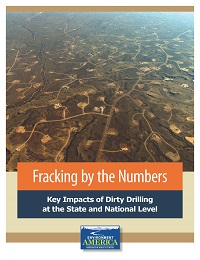For Immediate Release: Oct. 3, 2013
Montpelier, VT — As the Vermont Public Service Board considers a proposal to significantly expand the state’s long-term reliance on fracked natural gas, a new report out today measures the damage being done by this dirty drilling technology across the country.
The report, called “Fracking by the Numbers,” was written by the Environment America Research and Policy Center and was released in front of the Vermont Gas Systems headquarters by the Vermont Public Interest Research Group. The first study of its kind to measure the footprint of fracking damage to date – including toxic wastewater, water use, chemical use, air pollution, land damage and global warming emissions.
“Just one year ago, Vermont became the first state in the nation to outlaw fracking for gas or oil,” said Paul Burns, executive director of VPIRG. “This report proves that was the right decision. The numbers don’t lie, fracking has taken a dirty and destructive toll on our environment. If we expand our reliance on fracked gas in Vermont, we’re just exporting the harm someplace else.”
The report notes that 82,000 fracking wells have been drilled in the U.S. since 2005. Those wells have required the use of 280 billion gallons of water and at least 2 billion gallons of chemicals. They have resulted in the release of at least 100 million metric tons of CO2-equivalent greenhouse gas pollution.
In 2012, fracking operations around the country produced 280 billion gallons of toxic wastewater. Often laced with cancer-causing and even radioactive material, toxic fracking waste has contaminated drinking water sources from Pennsylvania to New Mexico. And the damage doesn’t stop there. In a single year, processes linked to fracking in the U.S. emit 450,000 tons of noxious air pollution.
“Once upon a time people dreamed of natural gas as a cleaner fossil fuel,” said Burns. “But now it’s clear that fracking is an environmental and public health nightmare.”
Officials from Vermont Gas Systems – the proponents of the fracked gas pipeline expansion – have intentionally downplayed any risks associated with fracking. Company CEO Don Gilbert suggested in one interview that fracking for gas was the equivalent of drilling a drinking water well. In another interview he said believed that fracking in Pennsylvania was being done in a safe and environmentally conscious manner.
Yet, a study published just yesterday in the journal Environmental Science and Technology, shows that naturally occurring radiation brought to the surface by the fracking process in Pennsylvania has contaminated a creek with radium in concentrations 200 times above normal, or background levels.
According to an article in Bloomberg news yesterday, the radium, along with salts such as bromide, came from a water treatment facility about 45 miles east of Pittsburgh. The plant treats wastewater from oil and gas drilling.
“Vermonters deserve to know the truth about fracking. This is not like drilling a backyard water well, despite what Vermont Gas says. It’s a dirty and dangerous way to satisfy our addiction to fossil fuels and the fact that we’ve banned it here already is all the more reason why we should not tolerate another fracked gas pipeline in Vermont,” said Burns.
The full report by Environment America can be found here: http://bit.ly/FrackingbyNumbers
###

